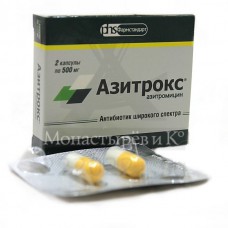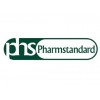Expiration date: 01/2025
Release form and composition:
Capsules white ? 0 the contents of capsules-white or white powder with a yellowish hue.
1 capsule contains:
azithromycin (in the form of dihydrate) 250 mg
Auxiliary substances: mannitol (mannitol), corn starch, magnesium stearate, sodium lauryl sulfate.
The composition of the body and capsule caps: titanium dioxide (E171), medical gelatin.
6 PCs. - packaging sells contoured (1) - packs of cardboard.
Capsules solid gelatin, ? 00, with a white body and a yellow cap the contents of capsules-powder white or white with a yellowish hue.
1 capsule contains:
azithromycin (in the form of dihydrate) 500 mg
Auxiliary substances: mannitol (mannitol), corn starch, magnesium stearate, sodium lauryl sulfate.
The composition of the capsule shell: titanium dioxide (E171), quinoline yellow dye (E104), stain sunset yellow (E110), gelatin medical.
3 PCs. - packaging sells contoured (1) - packs of cardboard.
Pharmacological action:
Broad-spectrum antibiotic, representative of the subgroup of macrolide antibiotics – azalides. Binding to 50S ribosome subunit, inhibits peptidtranslokazu on the stage of the translation, inhibits protein synthesis and slows the growth and reproduction of bacteria. It acts bacteriostatically, has a bactericidal effect in high concentrations. It acts on extracellular and intracellular pathogens.
Active against gram-positive cocci: Streptcccus pneumniae, Streptcccus pygenes, Streptcccus agaactiae, streptococci groups C, F, and G viridans Streptcccus, Staphycccus aureus gram negative bacteria: Haemphius infuenae, Mraxea catarrhais, Brdetea pertussis, parapertussis Brdetea, Leginea pneumphia, Haemphius ducreyi, Campybacter jejuni, Neisseria gnrrheae and Gardnerea vaginais some anaerobic microorganisms: Bacterides bivius, Cstridium perfringens, Peptstreptcccus spp. and Chamydia trachmatis, Mycpasma pneumniae, Ureapasma ureayticum, Trepnema Minify, Brreia burgdferi.
Azithromycin is not active against gram-positive bacteria resistant to erythromycin.
Pharmacokinetics:
Suction
After taking the drug inside azithromycin is rapidly absorbed from the gastrointestinal tract due to its stability in acidic medium and lipophilicity. After ingestion of 500 mg of azithromycin Cmax in plasma achieved through 2.5-3 h and is 0.4 mg/l. Bioavailability is 37%.
Taking the drug simultaneously with food slows down and reduces the absorption of azithromycin.
Distribution
Azithromycin penetrates well into the respiratory tract, organs and tissues of the urogenital tract (in particular, the prostate gland), into the skin and soft tissues. High concentration in tissues (10-50 times higher than in blood plasma) and long T1/2 due to low binding of azithromycin to plasma proteins of blood, as well as its ability to penetrate into eukaryotic cells and concentrate in an environment with low pH, environmental lysosomes. This in turn determines the large apparent Vd (31.1 l/kg) and the high plasma clearance. The ability of azithromycin to accumulate mainly in lysosomes is especially important for the elimination of intracellular pathogens. It is proved that phagocytes deliver azithromycin to the sites of infection localization, where it is released in the process of phagocytosis. The concentration of azithromycin in the foci of infection is significantly higher than in healthy tissues (on average 24-34%) and correlates with the degree of inflammatory edema. Despite the high concentration in phagocytes, azithromycin has no significant effect on their function.
Azithromycin remains in bactericidal concentrations in inflammation within 5-7 days after the last dose, which allowed to develop a short (3-day and 5-day) courses of treatment.
Metabolism
In the liver azithromycin demetiliruetsa, metabolites formed are inactive.
Breeding
Removal of azithromycin from blood plasma takes place in 2 stages: T1/2 is 14-20 h in the range of 8 to 24 h after taking the drug and 41 h – in the range of 24 to 72 h, which allows the drug 1 time/day.
Indications:
Infectious and inflammatory diseases caused by microorganisms sensitive to the drug:
- infections of the upper respiratory tract and ENT organs (including sore throat, sinusitis, tonsillitis, otitis media)
- scarlatina
- infections of the lower respiratory tract (including bacterial and atypical pneumonia, bronchitis)
- infections of the skin and soft tissues (including erysipelas, impetigo, secondary infected dermatoses)
- infections of the urogenital tract (including urethritis and/or cervicitis)
- Lyme disease (borreliosis) in the initial stage (erythema migrans)
- diseases of the stomach and duodenum associated with Heicbacter pyri (as part of combination therapy).
Dosage regimen:
Azitrox® is taken orally 1 time / day for 1 hour before or 2 hours after meals.
Adults with infection of the upper and lower respiratory tract appoint 500 mg/day for 3 days (course dose – 1.5 g).
In infections of the skin and soft tissues appoint a dose of 1 g/day for 1 reception on the first day, then - 500 mg/day daily from 2 to 5 days. Course dose-3 g.
In uncomplicated urethritis and/or cervicitis appoint one 1 g.
In complicated, long-lasting urethritis / cervicitis caused by Chamydia trachmatis, 1 g 3 times at intervals of 7 days (taking the drug in 1-7-14 days of treatment). Course dose is 3 g.
In Lyme disease (borreliosis) for the treatment of stage I (erythema migrans) appoint 1 g in the 1st day and 500 mg daily from the 2nd to the 5th days. Course dose-3 g.
When ulcers stomach and duodenal ulcers associated with Heicbacter pyri, appoint 1 g/day for 3 days in combination therapy of H. pylori.
Children weighing more than 45 kg when infections of the upper and lower respiratory tract, skin and soft tissue, scarlet fever, the drug is administered at 500 mg/day (1 caps.) for 1 reception for 3 days.
Children over 12 years of age drug (caps. on 250 mg) appoint at the rate of 10 mg/kg 1 time/day for 3 days or on the first day - 10 mg/kg, then 4 days - 5-10 mg/kg / day for 3 days. Course dose - 30 mg/kg.
In the treatment of erythema migrans in children the dose of the drug (tab. 500 mg) is 1 g on the 1st day and 500 mg daily from the 2nd to the 5th days. Course dose - 3 g. Apply Azitroks® in the form of tablets of 250 mg should be the dose of 20 mg/kg in the 1st day and 10 mg/kg from the 2nd to 5th day.
Side effect:
From the digestive system: diarrhea (5%), nausea (3%), abdominal pain (3%) 1% and less – dyspepsia, flatulence, vomiting, melena, cholestatic jaundice, increased activity of hepatic transaminases in children - constipation, anorexia, gastritis. Possible candidiasis mucous membranes of the mouth.
From the side of cardiovascular system: palpitations, chest pain (e1%).
From the Central nervous system: dizziness, headache, drowsiness in children - headache (in the treatment of otitis media), hyperkinesia, anxiety, neurosis, sleep disorders (e1%).
From the sexual system: E1 % - vaginal candidiasis.
From the urinary system: e1 % - nephritis.
Dermatological reactions: in some cases – rash, photosensitization.
Allergic reactions: rash, itching, Quincke edema, urticaria, conjunctivitis.
Other: fatigue.
Contraindications:
- liver failure
- renal failure
- children with body weight less than 45 kg (for capsules 500 mg)
- children under 12 years of age
- hypersensitivity to antibiotics of the macrolide group.
With caution, the drug should be used in arrhythmia (possible ventricular arrhythmias, prolongation of THE Qt interval), in children with severe impaired liver or kidney functions.
Pregnancy and lactation:
The use of the drug during pregnancy is only possible when the intended benefit to the mother exceeds the potential risk to the fetus.
If necessary, the use of the drug during lactation should resolve the issue of termination of breastfeeding.
Special instruction:
Azitrox® should not be taken with food.
In the case of missing the next reception missed dose should be taken as soon as possible, and the next - at intervals of 24 hours.
It is necessary to observe a break of at least 2 hours between taking Azithrox and antacid drugs.
After discontinuation of treatment of reaction of hypersensitivity at some patients can remain that demands specific therapy under medical supervision.
Overdose:
Symptoms: when using the drug in high doses may increase side effects - severe nausea, temporary hearing loss, vomiting, diarrhea.
Treatment: gastric lavage, the appointment of activated charcoal, symptomatic therapy.
Drug interaction:
Antacids (aluminum - and magnesium-containing), ethanol and food slow down and reduce the absorption of azithromycin.
Azithromycin does not bind to cytochrome P450 isoenzymes. Unlike most macrolides, at present there is no interaction of azithromycin with theophylline, terfenadine, carbamazepine, triazolam, digoxin.
Macrolides (except azalidov) slow down the excretion and increase concentration in plasma and toxicity zikloserina, indirect anticoagulants, methylprednisolone, felodipine, and drugs undergoing microsomal oxidation (carbamazepine, terfenadine, cyclosporine, gexobarbitala, ergot alkaloids, valproic acid, disopyramide, bromocriptine, phenytoin, oral gipoglikemicakie means, xanthine derivatives, including theophylline), due to inhibition of microsomal oxidation in hepatocytes, while the application of azalides such interaction has not been noted to date.
With the simultaneous use of azithromycin with digoxin, an increase in the concentration of the latter is observed.
With the simultaneous appointment of warfarin and azithromycin (in normal doses), changes in prothrombin time were not revealed, however, given that the interaction of macrolides and warfarin may increase the anticoagulant effect, patients need careful monitoring of prothrombin time.
With simultaneous use of azithromycin with ergotamine and dihydroergotamine increases their toxicity (vasospasm, disesthesias).
With simultaneous use of azithromycin with triazolam is reduced ground clearance and enhanced pharmacological effect triazolama.
Lincosamine reduce the effectiveness of azithromycin.
Tetracycline and chloramphenicol enhance the efficacy of azithromycin.
Pharmaceutical incompatibility
Azithromycin is pharmacologically incompatible with heparin.
Storage conditions and terms:
List B. the Drug should be stored out of reach of children, dry, dark place at a temperature of from 15° to 25°C. shelf Life – 2 years.




